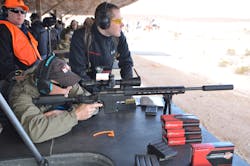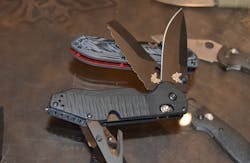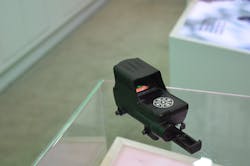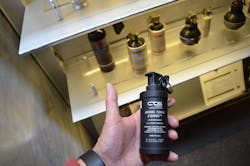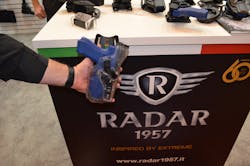Law Enforcement-Focused Products From SHOT Show 2019
I’m back from SHOT Show 2019, and it was an incredible show this year. I think we are getting to the point where this show needs to be broken up into major categories, just so we can cover everything. With that, let’s get started on some of the newest items that stuck out to me.
Benchmade 365 Outlast Knife
The Benchmade Outlast is truly made for the first responder. It has three blades — a CPM-S30V drop point, a CPM-3V serrated blade with a squared off tip and 02 wrench, a 440 rescue hook, and a carbide tip glass breaker. For a knife with two blades on one pivot, it certainly had a smooth action, using the Option Lock mechanism.
Winchester RANGER ONE Round
Winchester introduced a new, improved RANGER ONE round in 9mm, which included a rigid polymer insert seated inside the hollowpoint cavity. This design keeps the hollowpoint from being filled with materials that keep it from expanding. When they don’t expand, they over-penetrate, creating a dangerous situation. The RANGER ONE uses a bonded 147 grain bullet, which essentially doesn’t differ from their previous product. I have done ballistic testing on Winchester Law Enforcement 147 grain cartridges and they excel in after-barrier tests. I’d bet on the new RANGER ONE cartridges, especially knowing the clean burning powders they use for duty cartridges. They also have lacquered primers and a waterproofing agent applied to the case mouth. RANGER ONE 147 grain cartridges claim a 1,010 ft./s velocity, which is quite good for this bullet weight — perfect for a duty gun cartridge, but a little heavy for a short-barreled off-duty gun.
My friend Rob Pincus was on the range showing us these cartridges. He asked me if I noticed anything about them, holding a couple of them so I was looking down at the tip of the bullet. “They are blue,” I said. Then it hit me. “Oh, they are blue!” First, this is a fantastic design, however, all of us in the training business use color coding for different materials. Blue almost always means training. If something is marked blue, we consider it to be of training quality. Because of this, almost every provider stays away from blue when it comes to something that is lethal.
FLIR Black Hornet Personal Reconnaissance System and Vehicle Reconnaissance System
I was walking past the FLIR booth when I noticed that they were flying what looked like a micro-sized helicopter. I looked at the monitor in front of the booth and realized I was on camera. This was my introduction to the Black Hornet Personal Reconnaissance System (PRS) and Vehicle Reconnaissance System (VRS).
Designed for dismounted soldiers, the heart of the PRS is the pocket-size Black Hornet flying sensor, a nearly silent miniature flying sensor that looks like a toy helicopter. The rotor wing is only 4.8 inches long and it weighs 1.16 ounces. As a squad deployed asset, an individual soldier can carry several Black Hornets. They deliver 25 minutes of flight time and can transmit data to the base station, which has a controller and a display. The display is smaller than most portable laptops, daylight readable and can be networked for integrated solutions. Since it is a FLIR product, its cameras give it a broad range of video sensors. The flying sensor has a field replaceable battery and can work in fairly challenging environments, including gusts of 20 knots. See if your drone operator wants to put the drone up in 15 knots and let me know what they say. It is capable of data linking, hovering and staring. While it’s flying, it literally looks like a large insect or a toy helicopter. It can precede the operator about 2 km.
Meprolight Foresight
The Meprolight Foresight looks like a beefed-up reflex sight. It isn’t particularly heavier than other reflex sights, but it definitely has a little more hood protecting the display. It is not a reflex sight in any sense of the word but literally a low power OLED display superimposed over sighting optics. When Elad Davidson, part of the project management for the Foresight told me this, I froze in my tracks. Engineers have been trying to do this for years and only Meprolight has responded with a viable solution. You see, superimposing an OLED takes more power than a “red dot”, is hard to get sharp edges (for a reticle), and can potentially create a dim display (decreases the amount of light transmission from the target).
Meprolight’s Foresight has a bright, crisp reticle, clear light transmission from the target, and +50 hours from the USB C rechargeable cell, depending on the features used in the display.
What’s the advantage of this design? It is a computer display, which allows loads of information for the shooter without losing focus on the target. The display has an available compass, bullet count, electronic level and five available reticles. Davidson told me that the platform is flexible and any useful information can be placed inside this display. It is magnifier and thermal compatible and the display has an ambient light sensor. Because it is a computer, it can store other information like bullet drop compensation, and log the current zero for a particular shooter or cartridge.
The Foresight is also capable of Bluetooth connectivity, which can transmit the zeroing profile or other information to an app. It will also have the capability for firmware updates, which would be a quick way to change reticles or calculate offsets for different weapon configurations.
The Foresight is a product of astounding engineering. Putting it up to my eye, the information is on the edges of the image, which leaves a very uncluttered reticle, with critical information in the margin.
CTS (Combined Tactical Systems) 9-Bang
CTS has long been the “go to” company for critical response units like SWAT. They are a U.S.-based munitions and tactical product company that supplies products for teams around the world. I was looking at 12-gauge less lethal sock rounds when the 9-Bang caught my eye. A flash bang is a distraction device that delivers a “loud and thunderous noise” usually combined with a bright flash. The 9-Bang has nine of these loud noises, set at 175 dB for law enforcement use. The first bang happens after a 1.5 second delay. Subsequent bangs appear to fire in a random pattern, which the suspect most likely cannot distinguish from real gunfire. I was impressed with the compactness and easily thrown body of the 9-Bang.
Mossberg MC1 Handgun
The Mossberg MC1 is a 9mm semiautomatic subcompact handgun with 6+1 or 7+1 capacity. It can be purchased with or without a cross-bolt safety. I definitely liked the way it shot, and the sights were easy to align, which is perfect for a pocket-sized defensive pistol. It has a reasonable number of serrations and texturing in the grip.
One of the most unique things I found about this handgun is the fact that it field strips by removing the slide back cover and the firing pin assembly. I’m sure that some shooters would wonder why it is designed this way. As an armorer, it means the shooter has to look (and hopefully inspect) the firing pin mechanism every time the gun is disassembled.
Armscor VR80 Shotgun
Armscor has outdone themselves with a 5+1 round semi-automatic gas operated shotgun with a fluted barrel and 7075 receiver. It comes with 5-round magazines, but 9 and 19 magazines are available. It has a reversible charging handle that can be swapped right in the field.
For a law enforcement shotgun, the design is outstanding. I fired a few rounds through this one, then watched our photographer, Alex Frampton, fire controlled pairs and rapid fire with it. It has a feel like a large AR 15, so it is quick to learn and easy to get accurate fire downrange.
Radar 1957 Holster
One of the coolest things I saw at SHOT was from the Italian holster company Radar 1957. This really isn’t an end user company, as they manufacture holsters for other major brands. Chances are that if you are in law enforcement, you have benefited from their designs.The model line I looked at was made of injection molded plastic. One of the versions they displayed was actually fielded by the British Army. This holster initially had a simple latching mechanism, which was changed to a dual latching mechanism that secures the rear of the gun. Daniele Bartelucci, who showed me the products and also acted as a translator for several of the other product reps, told me that some of their military products benefited from “holster mission creep.” It looked like some militaries wanted a holster that would work for guard duty, but still had security for airborne operations.
They had a Level V holster on display that had a trigger guard lock, something that secured the gun in the ejection port, a rotating hood, and a finger actuated lock all in the same design. The other features brought it up to Level V. They also had another product that had a rotating locking lid and finger pressure release.
I tried both of these holsters and was able to draw the gun as quickly as if there were no safety devices. I was amazed at the intuitive ability to overcome the locking devices from the master grip. The platform was incredibly fast. Reholstering the gun actuated two or more of the retention devices, depending on the holster model. They were extremely natural in their draw and reholstering.
Because none of the holsters relied on the rail or dust cover area of the handgun for retention, the Radar 1957 Duty System’s attached light version holster fit a certain type of handgun (in this case a Glock 17) and any light or device attached to the handgun, as long as the light or device fit in the channel. Since the holster doesn’t clamp on the light, the smoothness and security of the draw is the same with or without an attached light.
Their holsters also had a rotating puck platform which their product line snapped into any holster style, whether it was a paddle platform, drop leg, or anything in between. The device looked like a flat hockey puck, which allowed the user to quickly adjust the cant of the holster.

Officer Lindsey Bertomen (ret.), Contributing Editor
Lindsey Bertomen is a retired police officer and retired military small arms trainer. He teaches criminal justice at Hartnell College in Salinas, California, where serves as a POST administrator and firearms instructor. He also teaches civilian firearms classes, enjoys fly fishing, martial arts, and mountain biking. His articles have appeared in print and online for over two decades.
